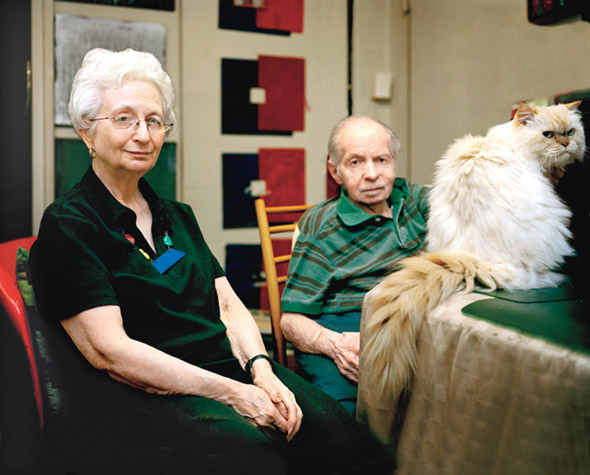The Unlikely Collectors

Herbert Vogel was a high school dropout, a World War II veteran, and, for most of his adult life, an evening-shift postal worker. Dorothy Vogel (nee Hoffman), his wife, was a librarian at the Brooklyn Public Library. Mr. Vogel’s salary, at its peak, was in the realm of $20,000; his wife’s, unreported, was likely not much more. They never had children, sharing their apartment with some pets (turtles and cats, mostly). Together, they lived in a rent-controlled one-bedroom apartment in Manhattan for nearly 40 years, until Mr. Vogel died on July 22, 2012. The news of his passing was major news — in the art world.
The Vogels, over their four decades together, had collected well over 4,500 works of art which, despite their meager means, were worth a fortune.
Herbert — Herb, as his friends called him — attempted a career as an artist into his late 30s or early 40s, but soon gave it up after, in his words, (per mental_floss) realizing he was “a terrible painter.” But his love of art didn’t disappear with his dreams of painting. He and Dorothy dedicated their lives to collecting art — even though they knew little, at best, about the world of art collecting. The mostly self-trained Vogels (Herb took a few classes in art history) relied mainly on their own tastes and intuition, with a significant focus on smaller, unknown artists. For example, during the first solo show (1965) of an early minimalist artist named Sol LeWitt, the Vogels became one of his first patrons. As ArtInfo reported in a lengthy obituary for Mr. Vogel, the couple purchased a golden, T-shaped sculpture — LeWitt’s first sale at his first solo show. LeWitt, as many art enthusiasts know, soon after became one of the most well known artists of his generation and genre.
Despite not having a lot of money, the Vogels had two things going for them. First, they collected for themselves and themselves only, and therefore were “investing” (to misuse a term — they were not in the business of reselling what they purchased) in things they liked, and not necessarily in artists whose work would appreciate over time. Second, they went direct to the artist, most often with cash. While typical art sales are made through galleries and brokers, those middlemen take a cut, and more importantly, take time to process payments to the artists. If you’re a so-called “starving artist,” cash in hand may mean the difference between making the month’s rent and not. When the Vogels showed up to your studio or show with a small pile of $20s, there’s a good chance that you’d sell to them.
Over time, the Vogels became known in art circles as the doyen and doyenne of the up-and-coming creative, further enabling them to find opportunities to add to their collection. As their apartment filled up, though, it became increasingly clear that the art needed to go somewhere other than under the bed, in drawers, and virtually everywhere else (except for the oven; they never stored anything there). In the early 1990s, they decided to donate their collection to the National Gallery of Art, because, in the words of Mr. Vogel (as recounted by the Washington Post), the couple “wanted to do something for the nation. The National Gallery doesn’t sell works they acquire. They’ll keep the collection together. And they don’t charge admission.” Some pieces of artwork were transported soon after; as the New York Times reported, “five full-sized vans were needed to move their art to the National Gallery.” Their collection was so extensive that the Gallery set up a “Fifty Works for Fifty States” program, placing fifty pieces of the Vogels’ in each of fifty museums across the country, one per state.
When Mrs. Vogel passes away, the remainder of their collection will enter the Gallery’s possession as well. Dorothy stopped collecting after Herb fell ill in 2008 or thereabouts; it was something they did together, and when he no longer could, she chose not to go alone.
Bonus fact: Art collecting can be serious business — and, also, less-than-serious business. In 2005, the Maspro Denkoh Corporation, a Japanese electronics company, looked to sell its art collection worth an estimated $20 million. Both Sotheby’s and Christie’s, the world-renowned auction houses, attempted to get that business. How did Maspro decide which auctioneer would run the auction — and, likely, collect well north of a million dollars in fees? A modified game of rock-paper-scissors. Each auction house sent a representative to Maspro’s offices, where they each wrote down their choice (in Japanese). Christie’s chose scissors, cutting Sotheby’s “paper.”
From the Archives: The Strategy Behind Rock Paper Scissors: In case you’re trying to win the rights to auction off a $20 million art collection.
Related: Herb & Dorothy: A documentary about the Vogels.
